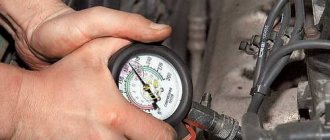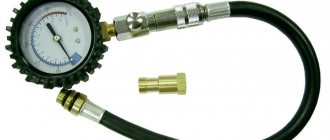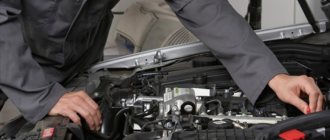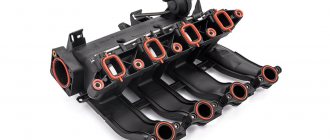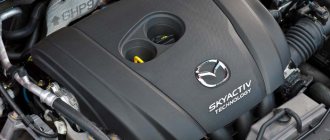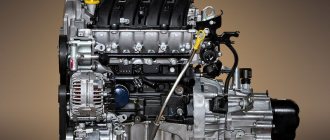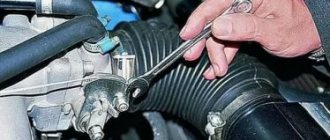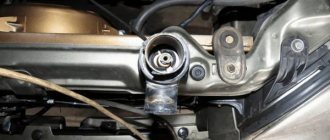A turbocharger is a compressor, or air pump, that is driven by a turbine.
The turbine rotates by using the energy of the exhaust gas flow. The rotation speed of a diesel engine turbocharger ranges from 1000 to 130,000 rpm. (this means that the turbine blades accelerate almost to the linear speed of sound). The turbine is directly connected to the compressor by a rigid axle. The compressor draws in fresh air through the air filter, compresses it and then pressurizes it into the engine intake manifold. The more air supplied to the cylinders, the more fuel can be burned, which increases engine power.
Theoretically, there is a power balance between the turbine and the compressor of a turbocharger. The more energy the exhaust gases have, the faster the turbine will rotate. As a result, the compressor will also spin faster.
Turbine
- Intake air
- Compressor rotor
- Compressed air
- Exhaust gas inlet
- Turbine rotor
- Exhaust gas outlet
The turbine consists of a housing and a rotor. Exhaust gases from the engine exhaust manifold enter the turbocharger intake pipe. Passing through the gradually narrowing internal channel of the turbine housing, they accelerate, and, having passed the snail-shaped housing, they are sent to the turbine rotor and cause it to rotate.
The rotation speed of the turbine is determined by the size and shape of the channel in its casing. It's like a watering hose; the more you block the outlet with your finger, the farther the water stream goes. The dimensions of the turbine and its housing depend on the specific engine.
Turbine housings vary significantly depending on the application. The turbine housing of a truck engine can be divided into two parallel channels, so that the rotor is exposed to two streams of exhaust gases.
With this type of housing, it becomes possible to use pulsed movement of gas flow and achieve resonance phenomena. Hence the necessity of separating the exhaust channels for each cylinder.
In the turbine housing, which has a double channel, each flow is distributed over the entire surface of the turbine rotor. Another housing design with two channels allows the use of pressure pulses (flow is distributed symmetrically on each side of the rotor).
In the constant-pressure version of the system, only the energy of the translational movement of the exhaust gases is used. In this case, only turbine housings with one channel can be used. This option is used in water-cooled cases used on marine engines.
Larger volume turbochargers often have an additional ring with guide vanes installed. It facilitates the creation of a constant flow of exhaust gases on the turbine rotor and makes it possible to regulate the flow. The turbine body is cast from an alloy with high heat resistance. The turbine rotor is also made from high-quality materials with high temperature resistance. The part through which the exhaust gases enter is called the intake, and the part going to the exhaust pipe is called the exhaust.
The turbine rotor is rigidly mounted on the axis. The axle material is different from the material used for the turbine rotor. This connection is assembled in the following way. The axle and rotor, rotating in opposite directions at very high speeds, are pressed against each other. The heat released during friction fuses them with each other, forming an inseparable connection. The axis at the junction is hollow. This void makes it difficult to transfer heat from the turbine rotor to its axis. On the turbine side of the axis there is a recess in which the sealing ring is located. The working surface of radial bearings is hardened and polished.
The protruding edge on which the ring will be pressed is machined with high precision.
The compressor rotor is installed on the thinner end of the axle; there is a thread on which a safety nut is screwed to secure the rotor. Once the axle is manufactured, it must be balanced as accurately as possible before it is installed in the housing.
How to get rid of turbo lag?
If you are wondering how to remove turbo lag, then you need to know that there is no need to change the turbine, you just need to make some changes to the functioning of the engine. So, many car enthusiasts turn to, which is one of the most accessible methods to get rid of turbo lag.
Chip tuning is the adjustment of the operation of electronic controllers. This effect can be achieved by adjusting the internal control programs of the vehicle. Experts use this term in two cases:
- when it comes to making changes to the control program that allow you to increase power;
- when auxiliary modules are used to solve the same problems.
The procedure not only improves power performance, but also performs the following functions:
- reducing fuel consumption;
- making adjustments to the control unit;
- installation of air blowers;
- switching to a different type of fuel;
- replacing basic injectors with ones that have greater performance.
In order to complete the chip tuning procedure, you need to go through several stages:
- The firmware is read through the control unit.
- Its correction occurs until the checksums in it reach the required values.
- New data is written to the controller.
Among the possible disadvantages of chip tuning:
- sensitivity to ambient temperature increases;
- the sensitivity of the engine to the quality of fuel intended for atmospheric engines is reduced;
- there is a need to compensate for the increased load on the supercharger by changing the cooling method and using higher quality, and therefore more expensive, lubricants.
Turbo lag can also be eliminated in another way. Installing a powerbox will be less expensive. So, this element is attached to the fuel sensor and, as a result, constantly changes the operating mode of the engine. The action occurs depending on the signals that are received. In addition, by installing a powerbox, you will certainly achieve the effect of reducing fuel consumption, and you will also be able to configure the device to perform specific tasks.
If we turn to the experience of professionals, the engineers decided to resort to replacing the turbine with one that has variable geometry. In another case, a mechanical turbine or a compressor is used to accumulate air. For example, the Volvo automobile concern uses a 2-liter cylinder containing compressed air in its production. When the throttle suddenly opens, it sends air to the cylinders. This is how the risk of turbo lag is eliminated.
Compressor
The compressor consists of a housing and a rotor. The size of the compressor is determined by the amount of air required by the engine and the speed of rotation of the turbine. The compressor rotor is rigidly fixed to the turbine axis and therefore rotates at the same speed as the turbine rotor. Compressor rotor blades, made of aluminum, are shaped in such a way that air is sucked through the center of the rotor.
The air sucked in this way is directed to the periphery of the rotor and, using blades, is thrown onto the wall of the compressor housing. Thanks to this, the air is compressed and enters the engine through the intake manifold. The compressor housing is also made of aluminum.
Design and principle of operation of a turbocharged diesel engine
The operating principle of a turbocharged diesel engine is based on the use of exhaust gas energy. Having left the cylinder, the exhaust gases enter the turbine impeller, rotating it and the compressor turbine mounted on the same shaft and built into the air supply system to the cylinders.
Thus, unlike atmospheric diesel engines, in turbocompressor units air is forced into the cylinders at a higher pressure. As a result, the volume of air entering the cylinder per cycle increases. In combination with an increase in the volume of burned fuel (the proportions of the fuel-air mixture remain unchanged), this gives a power increase of up to 25%.
To further increase the volume of air entering the cylinders, an intercooler is additionally used - a special device that cools atmospheric air before being pumped into the engine. From the school physics course we know that cold air takes up less space than warm air. Thus, during cooling, more air can be “pushed” into the cylinder per cycle.
As a result, a turbodiesel has a lower specific effective fuel consumption (in grams per kilowatt-hour) and a higher volumetric power (the number of horsepower per liter of engine displacement). All this provides the opportunity to significantly increase the total engine power without significantly increasing its dimensions and speed.
Bearing housing
The turbocharger is lubricated from the engine lubrication system. The axle housing forms the central part of the turbocharger, located between the turbine and the compressor. The axis rotates in plain bearings. Engine oil passes through channels between the housing and the bearings, as well as between the bearings and the axle. In most turbochargers, the radial bearings rotate at half the axle speed.
Currently, designs have appeared in which the bearing is stationary and the axis rotates in an oil bath. The oil not only serves to lubricate the axle, but also cools the bearings and housing.
To seal the turbocharger, oil deflector gaskets are installed on both sides. O-rings are also installed on both sides. But while these rings help prevent oil leaks, they are not actually gaskets. They must be considered as an element that impedes the leakage of air and gases between the turbine, compressor and axle housing. In normal operation of a turbocharger, the pressure in the turbine and compressor is greater than the pressure in the axle housing. Some of the gases from the turbine and part of the air compressed in the compressor enter the axle housing and, together with the engine oil, pass through the oil drain line into the engine oil sump.
All oil seals are dynamic type, i.e. work on the principle of pressure difference:
- The difference in axle diameters due to the action of centrifugal forces creates a pressure difference, which makes it difficult for oil to seep into the turbine.
- On the turbine side, the O-rings are located in recesses (both in the axle housing and on the axle itself). The same principle of installing rings is applied on the compressor side. O-rings are the element that plays a major role in ensuring tightness. In addition, they transfer heat from the axle to the body
- The O-ring rotates at the same speed as the axle. Thanks to the three holes in it, back pressure is created against the oil.
- The inside of the axle housing at the level of the ring has a complex sealed shape to prevent oil from leaking into the compressor.
- The pressure in the compressor and turbine forces the oil into the housing. Due to centrifugal force, a vacuum is formed behind the compressor rotor. Naturally, when the compressor is operating, oil leaks from the axle housing into the compressor may occur. The rotation speed of the turbocharger axis can be so high that it is impossible to avoid oil leaks using conventional cuffs (installed, for example, in a gearbox).
Therefore, several sealing rings are installed in the axle housing, using different methods to best seal areas of possible oil leakage.
How to get rid of turbo lag
At the moment, engineers have come up with only four ways to get rid of turbo lag or at least reduce its effect.
- Chip tuning is perhaps the simplest and most affordable way to combat turbo lag, but its implementation requires great precision, experience and responsibility. During the chip tuning process, specialists install (if necessary) and configure the electronic control unit.
- Powerbox Smart Diesel. Installing this gadget on the fuel sensor allows for more precise tuning of the engine depending on the signals received from it.
- Variable geometry turbine - this type of turbine is a relatively new, but nevertheless popular way to combat turbo lag at the production stage. Naturally, it is not possible to remake an existing turbine, so this method is the ultimate and requires replacing one turbocharger with another.
- Installation of a second turbocharger. This method of turbocharging modification is also popular only at the car production stage, since it requires a deep modernization of all engine systems. Turbocharging systems of this type can contain two, three or even four turbines.
Turbo lag is a moment when driving a car when you feel the weak efficiency of the power unit at low turbine speeds. You can hear about this effect from owners of both gasoline and diesel cars that have a turbine installed. Let's try to understand this concept and how to get rid of the unpleasant feeling.
Here are some of them:
Garrett turbocharger mechanical oil drain line.
In this compressor, the sealing ring plays a major role in sealing. When the engine operates at low speeds or without load, an area of low pressure (vacuum) forms behind the compressor rotor. The oil and gases that are in the axle housing rush between the back plate and the O-ring to the compressor.
As this mixture passes through the ring holes, the oil, which is heavier than the gases, is thrown toward the outside of the ring but remains in the axle housing while the gases continue to move through the compressor.
Thus, the O-ring, which rotates at high speed along with the turbocharger axis, acts as a centrifugal oil separator.
How to overcome turbo lag?
You can get rid of turbo lag only through timely diagnostics and tuning of the power unit and thanks to chip tuning. Thanks to this device, specialists change the settings of the electronic unit, selecting parameters according to special compliance tables. But this issue is very responsible and should only be carried out by qualified specialists. Another method to get rid of turbo lag in cars with a diesel unit is the integration of the Smart Diesel powerbox. The latter can be connected to a fuel sensor so that the engine changes its operating mode depending on the signals coming from the device. By using the device, fuel consumption will be reduced, and the car owner will be able to change driving modes depending on need. Technically, the problem with turbo lag can be solved by using a turbine with variable geometry or adding an additional mechanical turbine or compressor that will accumulate air when it is necessary to sharply accelerate the car.
What else is included in the turbocharging system?
The turbine is a complex unit; it took engineers several decades to perfect the system. Only at first glance, the solution to compensate for efficiency losses using exhaust gases seems simple. Even after the creation of the device, it had certain problems for a long time.
For example, it was not possible to solve the problem of turbo lag - a delay after pressing the gas pedal and starting the rotor. The solution was found in the form of using two valves. One of them was used to remove excess air, and the second was intended for exhaust gases. In addition, modern turbines have a modified blade geometry, which seriously distinguishes them from similar devices of the second half of the 20th century.
